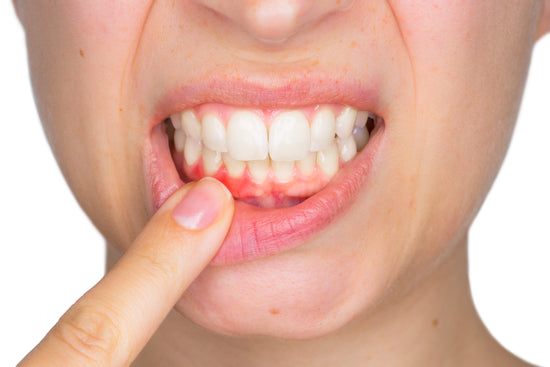 Gingivitis simply means an inflammation of the gums resulting from infection of the soft tissue surrounding the teeth (gingiva). This mild form of gum disease is a very common dental problem affecting up to 90% of individuals in the US at least once during their lifetime. Initial symptoms can be so mild that the afflicted may not even notice it.
Gingivitis simply means an inflammation of the gums resulting from infection of the soft tissue surrounding the teeth (gingiva). This mild form of gum disease is a very common dental problem affecting up to 90% of individuals in the US at least once during their lifetime. Initial symptoms can be so mild that the afflicted may not even notice it.
Fortunately, gingivitis is a reversible condition and may not result in any permanent damage, particularly if it is diagnosed and treated early on. However, if left untreated, gingivitis may progress to periodontitis, a more serious type of gum disease.
Causes
While several factors may contribute to gingivitis, the underlying cause is always excess bacteria accumulation in the form of plaque and tartar. Areas between the teeth and at the gum line are particularly prone to harbor bacteria.
Health Factors that Contribute to Gingivitis
While oral infections like gingivitis are far more likely to affect individuals with inadequate oral hygiene, there are also other health factors that increase the predisposition:
Hormone changes that occur during puberty, pregnancy and menopause.
Tobacco habits such as smoking and chewing tobacco weaken the immune system and can damage soft tissues in the mouth.
Injury to the gums such as damage caused by overly aggressive brushing or flossing, or misaligned teeth and braces.
Poor diet deprives the gums, teeth and immune system of essential nutrients required for optimum dental health.
Stress can indirectly aggravate gum disease by weakening the body’s immune system. Can also trigger unhealthy behaviors such as eating junk food, smoking or overly aggressive brushing.
Certain medications can interfere with the salivary glands and retard healing of damaged oral tissue.
Disorders undermining the immune system including cancers, chemo therapy, diabetes, HIV and other auto-immune illnesses.
Bruxism is the disorder characterized by grinding of the teeth, often during sleep. If left untreated, bruxism can wear down tooth enamel, cause gum recession and eventually loosen the root of the tooth.
Genetic factors those with a family history of gum disease have an elevated risk. The American Academy of Periodontology estimates that nearly 30% of the population has a genetic predisposition, which makes them six times more likely to experience periodontal problems.
Symptoms and Diagnosis
If the bacteria in plaque & tartar are not controlled by regular brushing and flossing, they release toxins that irritate and inflame gum tissues. Diagnosing gingivitis is simply a matter of you or your dentist finding evidence of the following symptoms.
- Inflamed, red, swollen or tender gums
- Bleeding after brushing
- Bad tastes or bad breath
- Excessive accumulation of plaque and tartar in and around the gumline
Prognosis and Complications
Addressing gingivitis is important because it’s the first stage in the progression to periodontitis. If left unchecked while the inflammation progresses, bacteria can penetrate deep below the gum line causing gum pockets to form where the inner layer of the gums (gingiva) start to separate from the teeth.
Eventually the periodontal ligaments break down, exposing the bone which holds the tooth in place. Bacteria and enzymes attack the bone causing bone decay and eventually teeth loosen and fall out. Gum disease is the leading cause of adult tooth loss in the United States.
The stages of periodontal disease
Healthy
- Firm, pink gums
- Gums tightly fitted to teeth
Gingivitis
- Swollen, red or inflamed gums
- Light bleeding
Severe Complications
Other possible complications from gum disease include:
- Agum abscess, which is an infection between the tooth and gum usually caused by food that gets trapped inside a periodontal pocket.
- Pregnant women may experience premature birth.
- Gum disease may worsen the symptoms of diabetes.
- Several studies have linked periodontal disease to heart attacks and stroke. This can happen when oral infections enter the bloodstream where they can spread and wreak havoc upon different parts of the body.
- Acute necrotizing ulcerative gingivitis (ANUG) or trench mouth is a potentially life-threatening infection that rapidly destroys oral tissues and may spread to the face and other parts of the body.
Prevention and Treatment
The primary means for prevention and treatment of gingivitis is to practice an effective oral hygiene regimen that includes:
- Regular brushing for two minutes at a time at least twice daily and flossing at least once daily. The American Dental Association (ADA) also recommends using a toothbrush with soft bristles to avoid further damage to the gums.
- Practicing healthy habits that promote dental health such as gentle brushing techniques demonstrated by your dentist, eating a healthy, low sugar diet and ceasing the use of tobacco products.
- If you have bruxism, wearing a mouth guard during sleep may significantly reduce damage to your teeth and gums.
What About Mouthwash and Gargling? Use of an antibacterial mouthwash may actually be counterproductive as these products often contain alcohol or soap (sodium lauryl sulfate) which both dry the mouth and reduce saliva production—an essential part of your mouth’s immune defense. Gargling with salt water, however, is a dentist-recommended natural home remedy that avoids these side effects.
Periodontal Pockets
- Formation of pockets between the teeth and gums where food and bacteria accumulate
- Gums begin to recede
Periodontitis
- Receding gums causing teeth to appear elongated
- Loose teeth, movement of teeth when biting, migration of the position of teeth
- Bad taste in mouth and bad breath
- Permanent damage to the jawbone
References
-
Whole-Body Dentistry: Discover The Missing Piece To Better Health – Mark A. Breiner, D.D.S. and Dr. Robert C. Atkins
-
Oxford American Handbook of Clinical Dentistry – Dr. John D. Da Silva, DMD, MPH, ScM, Harvard School of Dental Medicine
-
The Oral Health Bible – Dr. Michael Bonner, D.D.S.
-
Reversing Gum Disease Naturally: A Holistic Home Care Program – Sandra Senzon R.D.H.
-
Kiss Your Dentist Goodbye: A Do-It-Yourself Mouth Care System for Healthy, Clean Gums and Teeth – Dr. Ellie Phillips, D.D.S.
-
Complete Guide to Dental Health – Dr. Jay W. Friedman, D.D.S., M.P.H.
-
How to Save Your Smile and Your Wallet: Dentistry: Myths and Realities, A Patients’ Guide – Dr. Mark Lake, D.D.S.
-
Saving Money at the Dentist Office and Proven Methods for Pain-Free Dentistry! – Dr. M. Aviram, D.M.D., M.P.A.


